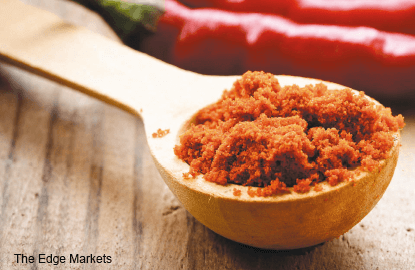
This article first appeared in The Edge Financial Daily, on October 7, 2015.

It’s a phrase that’s uttered over and over in this region: “You’re not a real Malaysian if you don’t eat spicy food!” The same goes for our neighbours — the Thais, Indonesians and Filipinos. What is it about chilli that has made it such a ubiquitous part of our dining culture? Unlike popular fruits such as durian and rambutan, chillies are not indigenous to this region. The plant itself originated in the Americas, where it was brought to the rest of the world via the Portuguese and Spanish explorers and traders who colonised South America.
Legend has it that Christopher Columbus was one of the first Europeans to encounter chillies, and called them “peppers” because of their resemblance in taste to the black and white peppers that were already well known in Europe. Today, five domesticated species of chilli peppers are cultivated, of which some are completely void of any spice, while others are capable of causing extreme pain within just a minute of taste.
Chillies are now known to contain large amounts of vitamin C, vitamin B, potassium, magnesium and iron, all of which are of great benefit to human health. In fact, a recent study done by the Chinese Academy of Medical Sciences tracked the health of half a million volunteers in China for several years, and surprisingly, managed to find that those who ate spicy food at least once or twice a week had a 10% lower mortality rate than those who ate spicy food less than once a week. Further, the mortality rate amongst those who ate spicy food six or seven days a week were even lower.
What the researchers found, was that people who consumed more chilli were also less likely to suffer from cancer, coronary heart disease and diabetes, possibly because of its powerful antioxidants. Unfortunately, people who suffer from digestive problems or peptic ulcers do not reap the same benefits.
In addition to boosting health, chilli has also been traditionally used as an analgesic, with the Aztecs rubbing chillies on their teeth and gums to numb the pain caused by toothaches. Studies have also shown that chillies are rather good at repelling bacteria and viruses — two vectors that can cause serious illnesses in humans. In fact, it is posited that the reason why the use of chilli in food originating from warm climates is so pervasive is because chillies were a useful additive to kill microbes in the food that humans consumed in this area before the advent of medicine and refrigeration.
Therefore, the use of chillies in the myriad dishes originating from countries lining the equator — India, Malaysia, Thailand, Mexico and more — is two-fold. Not only do they enhance the flavours of our cuisine, they also historically helped keep sickness at bay.
Another less well-known benefit that eating chillies confers to us is its potential as a weight-loss tool. The University of Wyoming recently published a study which found that mice that had been fed a diet high in chillies exhibited increased metabolic activity, thereby causing the mice to burn more energy and gain less weight. On the other hand, a study done by the University of Adelaide found that our stomach receptors interact with capsaicin (the chemical in chillies which makes them taste spicy) to help us sense when we’re satiated.
The real reason why so many of us enjoy torturing ourselves with spicy food, though, is because capsaicin binds to our pain receptors which our brains use to detect changes in temperature. It’s this that causes us to think that chillies are hot.
On the flip side, is that when our neurons are overstimulated from the consumption of chillies, they stop responding, after which endorphins are released. Now, we all know that endorphins are the “feel good” agents of our bodies — they’re what makes us love chocolate and seek thrills, for instance. It’s also why so many of us are inexplicably drawn to consuming copious amounts of chilli; although in this day and age, we no longer need it for its magical microbe-fighting abilities.